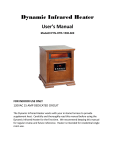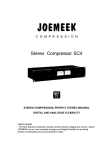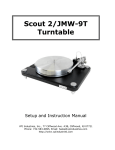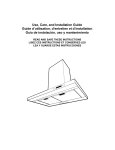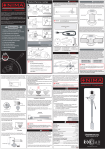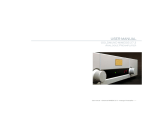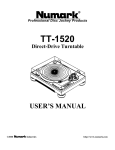Download Untitled - NEW HiFi
Transcript
GOLDMUND T5 TONE ARM USER MANUAL WARNING This high quality tone arm possess new technical features which are necessary for an accurate tracking of the today's records. Only a careful use can provide all satisfactions you are expecting. The mounting instructions must be SCRUPULOUSLY carried out. All handling must be performed according to the following instructions to avoid to deteriorate the tone arm. Nevertheless, if the instructions are perfectly carried out, you will notice that the use of the GOLDMUND T5 is quite simple and convenient. IMPORTANT : PLEASE DO NOT CONNECT ANY HIRE OR MOVE ANY PART BEFORE READING THE FOLLORING INSTRUCTIONS. 1. PRELIMINARIES Please read very carefully the following instructions. This high-precision tone arm will provide the best tracking conditions for any high-quality phono cartridge. For exacting technicians, musicians, and all those who demand the very best in record transcription , we strongly recommend the use of our GOLDMUND STUDIETTO turntable. 2. TECHNICAL DATA DYNAMIC SPECIFICATIONS - Effective mass high enough for the most recent moving coil cartridges. - Dynamically constant tracking force. - The pivot-to-stylus line is the tone arm inertia ellipsoid small axis. - Fluid damping located on the tone arm vertical axis and adjustable. - No elastic decoupling. - Counterweight and tone arm tube attached in one single point. GEOMETRICAL SPECIFICATIONS - Overall dimensions Total tone arm length : 245 mm. - Total rail length: 342 mm. - Total height: between 60 and 70 mm. - Effective dimensions Pivot to stylus length : 200 mm, - Effective height: 28 to 38 mm with a 18 mm high cartridge. - Tube axis to stylus: 13 mm. GENERAL DATA - Optimal theoritical balance of the tone arm. - Headshell, tube and pivot machined from one single solid piece of aluminum. - Large diameter tube damped by special inner structure. - Pivot type called "false unipivot" without lateral movement. - New kind of headshell giving perfect coupling between the cartridge and the tone arm tube. - Counterweight machined in lead. - Adjustable azimut. - Tone arm lift adjustable in speed and height. - Automatic lifting at the end of the record and if any trouble is detected during play. - Inner connections in Litz Wire - Gold-plated, spring-loaded cartridge plugs. - Carriage mounted on 3 ball bearing rolling on a V-shape rail. - Pilot arm adjustable vertically. - Very precise micrometric VTA adjustment with only two points to adjust and a locking device. - Easy set-up procedure on the turntable. 3. UNPACKING You will find in the packing: - the tone arm by itself, - the power supply, - the accessories box with one set of mounting screws, the belt, one special small headshell, three sets of screws for cartridge mounting, two alien keys for VTA adjustment and locking, two counterweights molded in lead, one bottle of damping fluid., one syringe for the damping fluid. To unpack these parts, please follow the procedure - Unpack the tone arm itself, without touching the carriage assembly (2, 4 & 7 on the schematic), handling it with the two sides (16 & 18). Take care of the small wires. - Don’t remove the parts holding the tone arm tube and the pilot arm (2 & 4) together. 4. BELT SET-UP - Open the cover (9) which is hold magnetically. - Unscrew and keep in the accessories box the white nylon screw which locks the carriage on the rail. - Put the cover back. NOTE: Avoid any brutal movement of the carriage. To move the carriage on the rail, always handle it with the transparent bar called "manipulation bar" (8). Never move the carriage by the pilot arm, - Set the belt on the two pulleys (13 & 14). The belt tension is adjustable by moving the outer pulley (14) screw and re-inserting it in a different hole. - Insert the top string of the belt into the clutch (21), in between the black plastic part and the steel wire. - The clutch is adjustable by its front screw (21) - If the clutch is not tight enough, the belt is slipping inside and even if the correction motor turns, the carriage does not move. - If the clutch is too tight, moving the carriage by hand becomes difficult and the rest position, close to the front side (16) is imprecise. - The right tightness is reached when by tightening it slowly, the point where the belt does not slip anymore is reached, and then one turn is added. ATTENTION: This adjustment will be checked later, when the tone arm will be totally set-up. It is also a good verification you can make after some weeks of good functionning. 5. SET-UP ON THE TURNTABLE Unscrew with the allen key found in the accessories box the three locking screws of the vertical adjustment (12b) - Insert the two allen keys in the two VTA adjusting screws (12). Remove the rail from the tonearm base by turning the two keys simultaneously counterclockwise. ATTENTION: Never turn one of the keys more than three turn without turning the other one of the same amount ire the same direction. Otherwise you may severely damage your arm. - Remove the tone arm base. - If you mount the tone arm on a GOLDMUND STUDIETTO or STUDIO turntable, the following step is not necessary. - If you don’t use one of the GOLDMUND turntables, use the schematic to trace the drilling pattern, and drill the 4 holes required. - If you use a GOLDMUND turntable, remove the screws mounted, on your turntable top plate and located in the base attachment position. - Use the 4 mm screws found in the accessories box to lock the base in position. Don't tight the screws to allow the base to glide on the top plate of the turntable. These screws will be locked later in the mounting process. - Set the tone are back on the base. Take care the locking screws (12b) are unscrewed enough to let the rail be inserted freely on the base. Turn down the two VTA adjustment screws (12), avoiding again to turn one more than the other one. A very good process is to insert both allen keys and turn them of the same amount of turns simultaneously. - Lower the rail as much as possible without tightening the VTA screws. Don't lock the three lateral locking screws (12b). 6. CARTRIDGE SET-UP - For the following steps leave the stylus cover on your cartridge. - Unlock the tube of the tone arm from the pilot arm by unscrewing the two white nylon screws of the locking clamp. - You will find in the accessories box three sets of special screws to mount your cartridge on the headshell of the GOLDMUND T5. Choose the length adapted to your cartridge. - Mount your cartridge on the small headshell with the special screws without tightening too far. The top of the cartridge must be kept 3 mm apart from the headshell surface. The headshell has a flat side and one indented. The indented one is facing the cartridge body. - Insert the four plugs of the tonearm wiring on the cartridge pins, following the international code: - Red : Hot wire, right channel. - Green : Ground wire, right channel. - White : Hot wire, left channel. - Blue : ground wire, left channel. The very high quality plugs used by GOLDMUND are not adjustable in size, even if they accept a large majority of the current cartridge pins. Your GOLDMUND dealer may provide you with smaller plugs of the same quality if needed (old KOETSU, SUPEX, etc..) - Insert now the headshell and cartridge on the tone arm end (1). Take care of the thin wires. Don’t push the body of the cartridge and the headshell too far toward the tone arm tube. Leave 2 mm of play. Slightly tighten with an appropriate screwdriver the two special cartridge screws. To help this operation, please note that the GOLDMUND T5 is adjustable in azimut and that you can turn the tube on itself easily (see next #) 7. TONEARM POSITION ADJUSTMENT - The GOLDMUND T5 tone arm is adjustable in azimut. You must first adjust approximately the tone arm to align the cartridge body vertically. To adjust azimut, make the headshell-cartridge assembly turn around its own axis while holding the pivot assembly (5) in rest position. - This adjustment may be improved by listening or with measurement equipment after the whole set-up of the tone arm. - Adjust approximately the VTA with the two screws (12) to let the tone arm move freely over the platter. One locking screw (22) avoid the carriage to move too close to the center spindle of the turntable. - Let the tone are base move laterally until the line plotted by the stylus when the carriage moves on the rail, cross the center of the spindle. Mark the tone arm base position (with adhesive tape). - Keep the tone arm in this position. Remove the rail from the base as previously explained, using the two allen key. - Lock the tone are base to the turntable top plate by tightening the four screws. - Reinsert the rail and lower it with the two allen keys. - Remove the lock (22) by screwing it down. Slightly loose the two cartridge screws. Move the tone arm base enough from the spindle to see if the line plotted by the stylus is effectively crossing the center of the spindle. Improve this adjustment by slightly sliding the cartridge on the tone are extremity. Then tighten the cartridge screws. - Lift the locking screw (22) in the locked position. ATTENTION: It may be important to understand that the perfect position is reached as soon as the stylus line is crossing the center of the spindle, even if the tone arm side is not perfectly parallel to the turntable side. A well designed straight-line tone arm is built to allow the stylus of the cartridge to follow a line as straight as possible, As soon as this line cross the center of the spindle the tangential position is secured. The previous page schematics show three correct positions, even if the tone arm is generally aligned parallel to the turntable side for obvious aesthetic reasons. 8. TRACKING FORCE ADJUSTMENT - Select the counterweight adapted to your cartridge. Insert it on the back portion of the tone arm tube with the locking screw on the top. To reach the correct balance, you may have the counterweight either too close to the pivot or too far. It means that you have not selected the proper counterweight. Take the other one, before adjusting the tracking force. NOTE: If you use a very heavy cartridge, you way need a special very heavy counterweight. Consult your dealer to get a special GOLDMUND counterweight. - Adjust now the proper tracking force, using a good gauge to fix it-properly. When the balance is reached, tighten firmly the locking screw on the top of the counterweight. 9. CONNECTIONS To proceed to the following adjustments, you will need to cue up and down your tone arm many times. Because your GOLDMUND T5 uses an electrical cueing operation, you must now proceed to the power supply connection. The other electrical connections are described in the step 11. - Connect first the power supply mini plug to the back socket of the T5. The proper socket is located on the back side of the tone arm (18), opposite side of the phono jacks. - Check the mains voltage of the power supply and connect the transformer to the wall plug. - You way now notice that a light is glowing on the carriage transparent handling bar (8) as soon as the carriage is not in the rest position. It shows that your power supply is properly connected. - If you push the carriage from the rest position until the stylus is over a record, you way now try to cue it down by pushing the cueing button (17). One pressure on the button and the tone arm lifts up, another pression and it lifts down. Cue it up now for proceeding to the next adjustments. 10. VTA ADJUSTMENT In a previous step, you lowered the rail on the base until the two VTA screws (12) are fully down. You must now understand that, when you will turn now both screws up of the same number of turns, the tone arm rail will remain in a position parallel to the previous one. If the turntable is horizontal, the rail will remain horizontal too. - Put an old record on the platter. Move the carriage until the stylus is approximately in the middle of the record. - Cue down the tonearm. Check if the tonearm tube is parallel to the record surface. If not, you will cue the tone arm tip and turn the two VTA screws (12) of the same number of turns until the tonearm tube is approximately parallel to the record surface. Cue up before each manipulation of the VTA screws. This adjustment will be later refined, when your tone arm will be totally installed. You will rapidly notice when playing with the VTA adjustment that each cartridge has its own optimal angle, easily perceivable by listening. To find this optimal tonearm vertical position, you must proceed with successive small "up" or "down" movements around the position given by the instructions of the cartridge manufacturer until you reach the best sound quality. - When the proper angle is found, your tone arm should be locked in its optimal position using the three locking screws (12b). ATTENTION: Never turn the VTA screws if the locking screws are tightened. Otherwise, you may damage the tonearm. 11. MORE CONNECTIONS The connections of your GOLDMUND T5 are all located on the back side of the tone arm (18). From left to right, you will find : - A mini jack (diameter 2.5mm) to connect the power supply. - A mini jack (diameter 3-5mm) to connect the cueing switch of the GOLDMUND STUDIETTO. - The grounding connection (5 ways black binding post). - The two RCA audio sockets for the signal connection. The right channel is indicated with a red ring on the plug, the left one with a white ring. - Check first the power supply connection already made. If you use a GOLDMUND STUDIETTO, let the power supply wire come through the large hole drilled in the turntable top plate behind the back side of the T5. - Connect now the ground post of the tone arm to the ground post of the preamplifier with a flexible wire. - Let the two audio cables (left and right channel) come through the back hole of the turntable and insert the right and left connectors in the tone arm plugs. Take care that these cables make a loop large enough to avoid the suspension of the turntable to be altered. - On the GOLDMUND STUDIETTO, you way now insert the mini jack of the cueing control coming from the turntable base into the remaining socket. The cueing of your GOLDMUND T5 tone arm may now be activated from the control panel of the STUDIETTO. 12. INSTRUCTIONS FOR USE - To switch on your tone arm, push the carriage out of the rest position. A red light must appear in the "handling bar" - When you move the carriage always handle it by the "handling bar". In this transparent bar, three lights are located : - A red led (toward the cartridge end of the bar). shows that the electrical cueing is in progress. - A green led shows that a correction of the tone arm is in progress. - A red led (toward the counterweight end) shows that the tone arm is in a position where no correction is required (rest position or good tangency with the groove). - The electronic adjustments described below are accessible on the top of the rail by three holes. Use a small screwdriver to reach the potentiometers through the visible holes. IMPORTANT: The following electronic adjustments are only accessible for servicing. The correct settings are adjusted by the factory during the final test of your GOLDMUND T5 tone arm. They usually never need to be readjusted. - Potentiometer no 0 (no engraved mark) : This potentiometer is accessible through the only hole visible on the top of the rail when the carriage is in the rest position. This is the adjustment of the delay for the automatic cueing up at the record's end. - Potentiometer no I (one engraved dot) To reach this adjustment, you must push the carriage toward the center of the record. The potentiometer no I adjust the speed of the correction motor. A too -fast speed is not good for the sound quality. When the speed is too slow, the motor may have not enough strength to pull the carriage and the correction way not be performed properly. - Potentiometer no 2 (two engraved dots) : Adjust the cueing speed. 13. DAMPING ADJUSTMENT To reach the damping fluid well, remove the cover of the carriage (9). The Nell is visible, close to the tonearm pivot. The viscosity of the fluid provided is adapted to the best today's cartridges. The perfect damping adjustment is reached by increasing or decreasing the quantity of fluid in the Nell. The sonic result is easily detectable. A too low damping induce bright sound, loose low end and brittle highs. A too high damping induce deadness and a nondynamic sound. To fill and drain the fluid, use the syringe provided in the accessories box. ATTENTION: The fluid well cannot take more than 2cc. If you fill it too much, the fluid may spread around the pivot. A small quantity of the fluid is much enough to damp the tonearm properly. To reach the perfect damping may require some use. The only good and accessible tool to help to this adjustment is the listening. Be patient and exercise. 14. FINAL ADJUSTMENTS You may, after few hours of use, refine some of the adjustments previously made, as the VTA adjustment (see page 15-16). the azimut adjustment (see page 12), the damping adjustment (page 19), or the belt tension (page 7). Consult your nearest GOLDMUMD dealer if you need any help. 15. CLEANING To clean the tone arm, use soft brushes. Always clean it dry. If you may use a good chamois leather, it is a better way to avoid any scratch. You may, to have the best polish, slightly impregnate your wash leather with GOLDMUND CLEANER.













